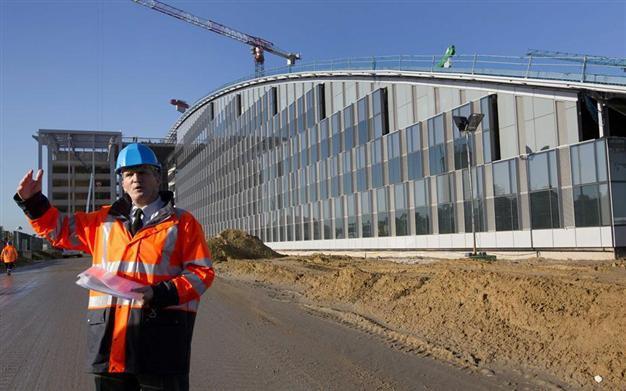NATO puts its faith in new high-tech HQ
BRUSSELS - Agence France-Presse

Director of NATO headquarters project and program manager Tony Carruth speaks outside the new NATO headquarters, currently under construction in Brussels November 13, 2013. REUTERS
Looking to a new role, NATO is pressing ahead with a high-tech, high-security headquarters to replace the supposedly temporary residence it ended up having to use for 50 years.
Halfway through construction, the futuristic building of all-glass facades and interlocking concrete wings on the outskirts of Brussels is fast taking shape.
"We are on track with the calendar and the budget," said Tony Carruth, head of the NATO HQ project office, during a visit this week.
"We have been here -- in the old building -- much longer than what had been planned," Carruth said, describing the drab, low-profile HQ as having been "designed in the time of the type-writer." The US-led military alliance was born in the Cold War stand-off with the Soviet Union, but since the September 11, 2001 terror attacks on the United States, it has taken on a wider scope of operations, playing a key role in Afghanistan.
Next year, however, the NATO Afghanistan mission comes to an end, with the focus switching to a future of cyber- and information-warfare.
The new HQ will cost about 750 million euros ($1 billion), a big enough budget to raise some eyebrows when militaries around the world are complaining about stiff budget cuts.
"The new headquarter is far from extravagant," NATO Deputy Assistant Secretary General Matthew Klimow said.
"It is a functional building that will allow us to say that NATO is ready for 21st-century challenges.... This (old) building has outlived its usefulness," Klimow said.
Member states approved the headquarters plans in 1999, well before the global economic slump, in what was seen as a vote of confidence in NATO's future after the collapse of the Soviet Union.
The current HQ, just across a busy highway out to the airport, dates from 1967 and was originally meant to be a stop-gap solution after then-host France withdrew from NATO's military structures and commitments.
France returned to full membership in the alliance in 2009.
The alliance now counts 28 members, up from 15 in 1967, as it has welcomed into the fold many ex-Soviet countries in eastern Europe.
A major part of the new HQ's budget is devoted to security in its widest sense for the 4,000 people working there each day.
Security "is clearly a priority for an institution such as NATO," said Colonel Lieen Vahheste, who is overseeing the works on behalf of the Belgian government.
Just as the September 11 attacks changed NATO's role, so they changed the building's requirements -- the facades and glass areas, including a huge central atrium where the wings join, are reinforced and protected against possible bomb blasts.
Similarly, the perimeter has been upgraded with an anti-intruder system to deter unwanted visitors.
As for the new threats of cyber-attacks and espionage, officials are extremely circumspect in what they will say, with the subject made even more sensitive by recent revelations of US spying on its allies.
Snooping "is not only carried out by countries outside NATO such as Russia, but also between ourselves," one diplomat noted drily.
Brussels, home to the major institutions of the European Union and many other international groups and businesses, plus a large diplomatic corps, has long been considered a real "spies' nest".
Despite such concerns, the new HQ "will not be a bunker," Klimow said.
"The new building is a vote of confidence in the future of NATO," said alliance spokeswoman Oana Lungescu.
